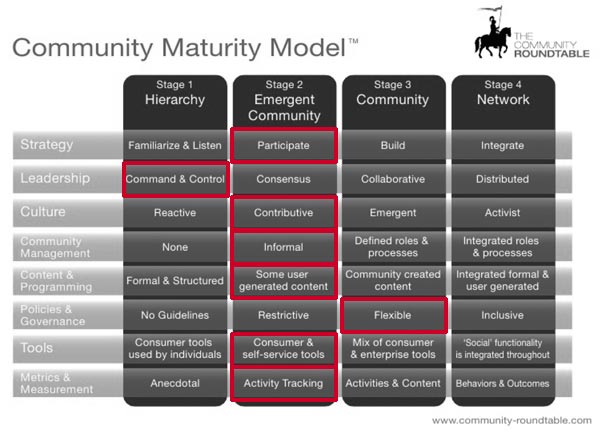As I make my exit from the University of Denver, I’ve decided to write one last series of posts outlining what I consider the state of social media at the university. To do so, I’d like to use The Community Roundtable’s Community Maturity Model as a starting point. The model is part of the Roundtable’s 2012 State of Community Management report. Below is the model with my determination of where DU sits. One caveat: I’ve ranked DU as a whole in this illustration rather than my department- MarComm- specifically. There’s a lot of variance in terms of social media sophistication across campus, so you may disagree with my overall ranking of DU and that’s OK. It’s probably worth ranking your own unit as a contrasting exercise to what I’ve provided.

The eight competencies on the Y-axis are the building blocks of a successful social media program. The X-axis contain the maturity stages that organizations go through as their competency increases. Again, some units will rank higher or lower than what I’ve indicated, but as a whole, I’ve placed DU squarely in the “stage 2: emergent community” space.
While DU ought to advance into stage 3 and beyond, it can’t. Our culture of decentralization (endearingly referred to as “the silo effect”) is the root problem (depending on how many onion layers you care to peel). It creates a gulf between stage 2 and 3 which proves difficult for us to cross (and, indeed, most any other siloed organization). While tools and resources like Yammer and the WebEd series of in-person and online workshops were intended to create a mechanism to cross that gulf, they have only achieved limited success, if any. Other initiatives, like the Center for Teaching and Leraning’s video manager tool currently under development and the recently created marketing confab group that pools marketings from across campus together, continually get us closer, but they haven’t yet gotten DU to cross the gulf. So the question is: what will?
To answer that question we ought to ask why we should at all. Clearly, students live and breathe social media, an idea that has (and is) fueling novel ways for people, organizations and information to connect with one another. It provides an opportunity to better connect our community and it’s wealth of knowledge. Yet, DU was late to the game, officially speaking. Without systems, processes and resources for departments to leverage, siloed approaches once again took root with all of it’s associated issues.
As I look back on my 2 year tenure as a social media strategist at DU, I do see a desire across campus, at least on a grass roots level, to create a whole that is greater than the sum of the parts. Of course, differing agendas, incentive structures and many other factors keep grass root efforts at the grass roots level. I believe DU needs to undergo fundamental change in terms of centralization versus decentralization before social media (and the web in general) become a springboard to a better student experience, lower costs, greater efficiencies and a model of DU’s desire to be a great university dedicated to the public good.
I’m very interested in reading and seeing the rankings you create for your own unit or for your own institution. Feel free to add rankings, issues, opportunities and anything else that’s relevant in the comments.